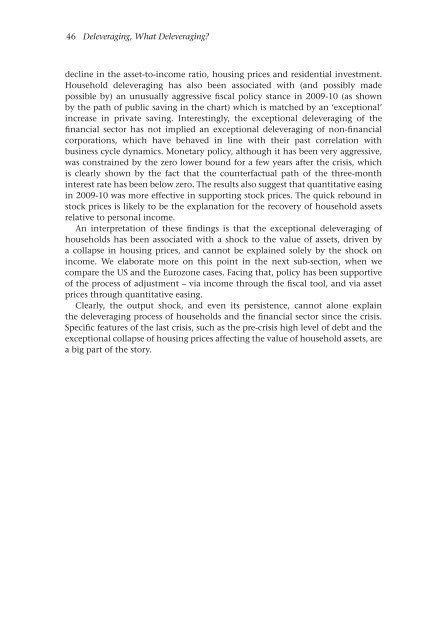1qGLG9p
1qGLG9p
1qGLG9p
You also want an ePaper? Increase the reach of your titles
YUMPU automatically turns print PDFs into web optimized ePapers that Google loves.
46 Deleveraging, What Deleveraging<br />
decline in the asset-to-income ratio, housing prices and residential investment.<br />
Household deleveraging has also been associated with (and possibly made<br />
possible by) an unusually aggressive fiscal policy stance in 2009-10 (as shown<br />
by the path of public saving in the chart) which is matched by an ‘exceptional’<br />
increase in private saving. Interestingly, the exceptional deleveraging of the<br />
financial sector has not implied an exceptional deleveraging of non-financial<br />
corporations, which have behaved in line with their past correlation with<br />
business cycle dynamics. Monetary policy, although it has been very aggressive,<br />
was constrained by the zero lower bound for a few years after the crisis, which<br />
is clearly shown by the fact that the counterfactual path of the three-month<br />
interest rate has been below zero. The results also suggest that quantitative easing<br />
in 2009-10 was more effective in supporting stock prices. The quick rebound in<br />
stock prices is likely to be the explanation for the recovery of household assets<br />
relative to personal income.<br />
An interpretation of these findings is that the exceptional deleveraging of<br />
households has been associated with a shock to the value of assets, driven by<br />
a collapse in housing prices, and cannot be explained solely by the shock on<br />
income. We elaborate more on this point in the next sub-section, when we<br />
compare the US and the Eurozone cases. Facing that, policy has been supportive<br />
of the process of adjustment – via income through the fiscal tool, and via asset<br />
prices through quantitative easing.<br />
Clearly, the output shock, and even its persistence, cannot alone explain<br />
the deleveraging process of households and the financial sector since the crisis.<br />
Specific features of the last crisis, such as the pre-crisis high level of debt and the<br />
exceptional collapse of housing prices affecting the value of household assets, are<br />
a big part of the story.


